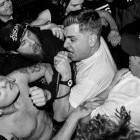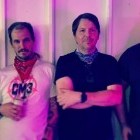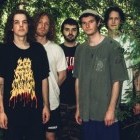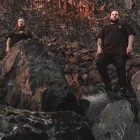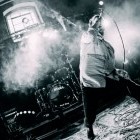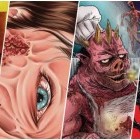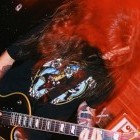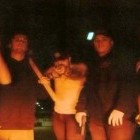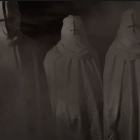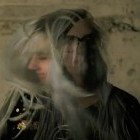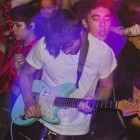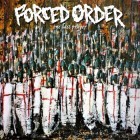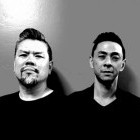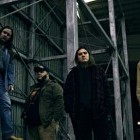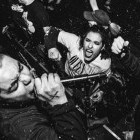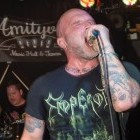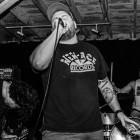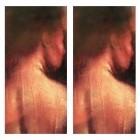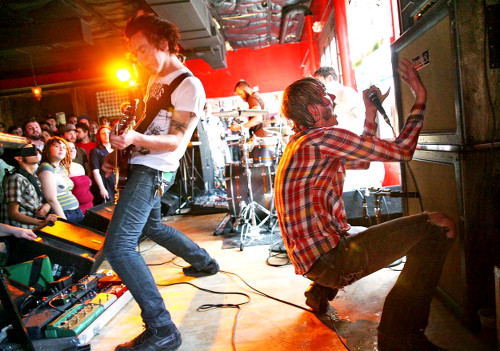
I've been an admirer of Ryan Frederiksen's guitar work since I first heard his former band, These Arms Are Snakes, back in the '00s. His playing style incorporated all of the riff-heavy stuff you would expect from a guitarist playing in a post-hardcore band, but he always added an element of surprise with the way he approached certain arrangements. It wasn't 'til a few years later that I found out that Frederiksen had actually spent time as a member of '90s Seattle hardcore band Nineironspitfire, but it wasn't a shocker since that group also had a fresh take on things.
After These Arms Are Snakes broke up at the end of the '00s, Frederiksen joined forces with members of Botch and Unbroken in Narrows, a hardcore band that signed with Deathwish Inc. and has put out a handful of releases to date. His latest group, Dust Moth, finds the guitarist exploring a new sonic path. The band's upcoming Scale album features ethereal vocals gliding over crushing guitars and a killer rhythm section.
With Scale about to hit stores, I chatted with Frederiksen about Dust Moth, and the bands that led him to this chapter in his story.
Were you born and raised in the Pacific Northwest, or did you move there when you were in your teens?
I was born and raised here in the Seattle area. I started out in West Seattle and then my folks moved just outside the city about 30 minutes to the east. I've spent most of my life here, but moved to Philly and then Louisville for a very brief time right after my first band, Nineironspitfire, broke up. I decided to go to school for graphic design and it was cheaper for me to move back to Seattle and not pay out-of-state tuition costs, so I did that.
What kind of music did you first fall in love with, and how did you find it in the first place?
I think I've always had an eclectic taste in music. My dad listened to all classic rock growing up and the stereo was always on. During dinner or working on cars it was on. He'd always quiz me on songs that came up on the radio.
SEE ALSO: 2016 interview with John Pettibone (Heiress, Himsa, Undertow).
Did you start playing guitar at a young age, and did you take any lessons?
I started playing guitar when I was about 14. One of my dad's friends brought one over and that was it, I was hooked. From that point on I knew I wanted to play guitar in some capacity. I took lessons for a little while, but the music I was listening to was so easy to play that I gave up on that. I was listening to punk already and that was all just basic punk/hardcore type stuff. Mark [Holcomb], who played with us in Dust Moth for a while, was a huge influence early on. He was the guy that made me think that I could be in a band.
Who were some of the other guitarists and bands that influenced your playing style early on?
I was a hardcore kid, for sure, but as far as guitar playing goes I started getting into stuff that was a little more difficult to figure out how to play. I loved Pitchfork and a lot of the late '80s early '90s DC bands. Then around the time I played in Nineironspitfire, it shifted to more of the stuff that was going on in the Chicago area like The Jesus Lizard, Shellac, Distorted Pony, Craw, and stuff like that.
What was the first band you played in, and did you record a demo or play out at all?
I was in a series of failed experiments up until Nineironspitfire. Nothing really of note and no demos or anything like that.
Okay, let's get into Nineironspitfire. How did you come to be in that band?
Nineironspitfire had started a little while before they asked me to play and I think I was maybe the 17th or 18th second guitar player [laughs]. Seriously, there were a lot. [Vocalist] John [Allen] and I were living together and we had talked about playing together and a vacancy opened up in Nineironspitfire. This was right before Seventh Soul Sacrificed came out, so I got credit on that record but I didn't play on it. If I remember correctly Demian was the only guitar player on that record.
Who were the bands that inspired the sound of the band? You guys had a unique bent to what you did.
The bands that inspired Nineironspitfire were a bit obvious at first (Deadguy, Today is the Day), but towards the end I think we started to come into our own a bit. Not that I had a part in that, but I think we started borrowing more ideas than actual riffs. We got really into Slint, Shellac, and stuff like that, so it was a lot less metallic and hardcore sounding.
SEE ALSO: 2016 interview with Mike McTernan (Damnation A.D., When Tigers Fight).
Listening back to the stuff Nineironspitfire did, how do you feel about it?
I loved being in Nineironspitfire. It was my first band that ever did much of anything, so I was super pumped on everything. We only did a few tours when I was in the band, but I knew that's what I wanted. The only thing I played on was a split we did with Botch and I really enjoyed that. We also recorded a couple other songs during that same session that never came out on anything, but I don't think any of us have a copy of it.
Why did Nineironspitfire break up?
Nineironspitfire broke up because it needed to. The last tour we did was one of my favorite tours I've ever done to this day, but it was rough. Not many people liked us which didn't help, but we weren't really getting along that great either so once we came back I decided to move to Philly and that was that. After that were more false starts and it wasn't until the demise of Botch that I was able to get anything going.
Your next band was These Arms Are Snakes, which also featured former members of Botch and Kill Sadie. I remember listening to the first EP (This is Meant to Hurt You) and thinking it sounded like Fugazi playing Deadguy and Voïvod covers.
My friend Bill and I were playing and recruited Joe [Preston] to play drums. We asked Brian [Cook] if he'd be interested in playing as well right before the last Botch show, so the four of us started jamming on some songs that didn't really go anywhere at first, but once we started all clicking, Bill left and we actually had some interest from a few people to sing and Steve [Snere] seemed most excited about it, so once he came down we knew that was it. I didn't want to go the hardcore route again so it was a blessing that Steve got involved. We definitely wanted it to be aggressive but in a Fugazi meets Led Zeppelin kind of way. Early on we wanted it to sound really big and full so that's why we added the keys. I loved Björk and Doves and really liked how layered their records sounded. I wanted it to feel like every time you listened to our record you could hear something you didn't notice before. It was a bit ambitious, I think. Live, we weren't anything like that. We were way more stripped down live and it took us a little while to realize that.
The first These Arms Are Snakes album, Oxeneers or the Lion Sleeps When its Antelope Go Home, came out in 2004. The sound of that material had a less "metal" approach, but there was a sense of evil lurking beneath. A great example of this is on the song "Angela's Secret," which has a nasty guitar riff in it that comes out of nowhere.
We did some touring on the EP and Joe decided it wasn't for him. We had set a timeline for ourselves to complete Oxeneers..., so we had [drummer] Erin Tate on loan to help us complete writing and recording. Without him we really wouldn't have been able finish that record. His style was different from Joe's and was a little more dance-y so that's why the record came out a less like the EP. Erin has an amazing mind for arrangements. "Angela's Secret" was based on the keyboard line and Erin really took it to another level with his ideas for the arrangement. Brian and I also both had a pedal that we really got into for that record. We sampled ourselves a lot to double certain parts and/or do harmonies.
What kinds of bills were you guys playing at that point? I don't think I saw you live 'til later.
Our band was both a blessing and a curse. We were able to tour with bands like Minus the Bear on one tour and Isis the next without it being weird. The problem was that those bands' fans didn't really care for us, so once we started going out on our own it was a ghost town for a little while. The bigger cities were always pretty great for us but once outside of those cities it really was tough going for a while.
SEE ALSO: 5 Great Post-Punk Songs That Aren't by Joy Division, The Cure, or Bauhaus
2006 saw the release of the second These Arms Are Snakes album, Easter. That had a really interesting album layout. Can you talk about the graphic design aspect of the band?
The layout for Easter was sort of a reaction to Oxeneers... I had planned on working with Steve on ideas for the layout and he kept changing his mind, so I had to come up with what I thought was his narrative for Oxeneers... I was, and still am, really big on having a cohesive idea for records. So whatever the lyrical content is is reflected in the artwork in some way. So, with Easter I decided to bypass Steve and come up with my own narrative. I had his lyrics so I still wanted to incorporate his ideas but in my own way. So I had Robin Laananen go to the Joshua Tree and get landscape shots to represent the mind and had Brian and my friend Demian Johnston do the illustrations to represent the lyrics. Brian did literal representations and Demian did interpreted representations of the lyrics. Then I combined all them to create one big cohesive idea. I used the standard printing process to further illustrate that point as well. The illustrations utilized only 100% values of Cyan, Magenta or Yellow to represent the different layers of the mind in the same way the printing process uses those colors/layers to create "full color" images. It's cheesy as shit and artsy, but it's the way my head works so I ran with it.
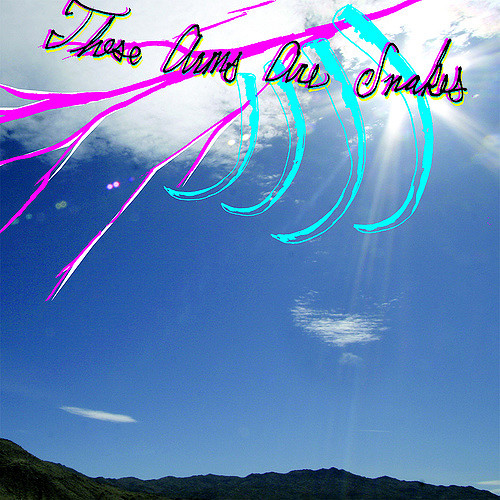
The band ended up parting ways with Jade Tree and signing with Suicide Squeeze for the remainder of its time together. How do you look back on your time with Jade Tree?
Not fondly at all. I won't really go into it, but they turned out to be a really shitty label. They did some extremely questionable things and thankfully Cathy Pellow at Sargent House and David Dickenson at Suicide Squeeze were there to help get us out of that mess.
In 2009, you released Tail Swallower and Dove, the third and final These Arms Are Snakes full-length. What's interesting about that record is that it's got a lot of left-of-center things going on in the songwriting, but the arrangements aren't all over the place. Do you think that's the album where everything came together from the songwriting standpoint?
That record was actually a tough exercise for us. At that point we hadn't really written any songs with traditional song arrangements, so we tried that out quite a bit for that record. Where it felt appropriate, of course. So, that record was about as pop as we were going to get. To be honest, I don't think it mattered how we wrote out our arrangements. It was still going to sound like These Arms Are Snakes.
Why did These Arms Are Snakes break up in 2009?
It just ran its course. We really liked to enjoy ourselves on tour and Brian felt more like a babysitter than a bandmate, and that shit gets taxing to say the least. Ultimately, I think we were done anyway. I felt like we grew a lot as a band in so many ways and that we didn't really have anywhere else to go.
SEE ALSO: 2016 interview with Don Fury (Producer: Judge, Quicksand, Gorilla Biscuits, Underdog, Inside Out).
Your next band was Narrows, a five-piece outfit that includes musicians who have played in Botch, Unbroken, and several other groups. What was the impetus for that project?
Narrows was around at the same time as These Arms Are Snakes. It had started as a project by [bassist] Rob [Moran] and [vocalist] Dave [Verellen] in 2007 or so, and didn't really get a lot of traction until they asked [drummer] Sam [Stothers] and [guitarist] Jodie [Cox] to play with them. Oddly, Rob and Jodie had toured together in Europe with their old bands [Some Girls and Bullet Union, respectively] and Jodie was These Arms Are Snakes' booking agent in the UK and Europe. So, Jodie and I were good friends and he'd fly over to the States to tour with us from time to time, and he got in touch with Rob to let him know that he was going to be in Seattle. Rob asked if he'd be into doing a little project and he grabbed Sam to play drums and then they asked me and that was that. JC has been our sixth member. Saying he is great is an understatement. He has been our fill-in guy for whenever somebody can't do a tour or shows. He originally was our go-to guy when Jodie was having Visa issues, and then I couldn't do a European tour and he filled in for me there and then he just played bass for our shows in April. He knows every song better than any of us [laughs].
But to back up, we got together at Rob's place a couple times and then finished writing the rest in the studio for our first 7".
Narrows is rooted in hardcore, but it's a unique sound you have going.
As far as our sound goes I think it is a perfect amalgamation of each of our personalities. You really can hear each person's previous band in the overall sound. We all have roots in hardcore but didn't want it to be a typical hardcore band. We were actually all pretty impressed with ourselves with that first 7" so we decided to keep at it. The biggest goal of that band was to do things we had never done before. Just touring-wise, I mean. We really want to get to places we haven't been before like South America, Central America, anywhere in Asia, Africa, and the Middle East. Anywhere, really. So we're working on that [laughs].
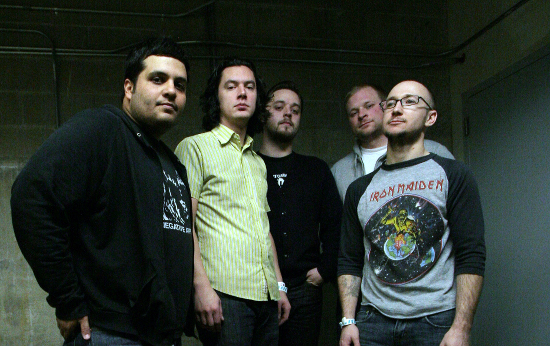
Narrows has released two albums, one EP, and two splits. What's the current status of the band?
Still ticking. We actually just played in April here in Seattle. We played two shows and had an amazing time. With Narrows everything takes a lot of planning, so that was about six months planning to do those two shows. Early on it was easier because we all lived in Seattle—except for Jodie, who lives in London. But now there are two members in San Diego, one in London, and two of us in Seattle. We're currently trading files back and forth for another as-yet-unnamed release. We're aiming to get a couple of those continents off our list.
SEE ALSO: Rob Moran (Unbroken, Narrows, Some Girls, Over My Dead Body).
That finally brings us to Dust Moth.
It started out as a project that Mark Holcomb, JC, and I conceived. Mark just moved back to Seattle from Los Angeles and we had always talked about playing together. We have almost identical musical tastes so we thought it would be a good idea. JC was living in Portland and we knew we wanted him to be involved. We love JC and his bass playing from his old band Sparkmarker, and he is the sixth member of Narrows, so I knew he would be fantastic. We were thinking we could go for a Doves meets Chavez meets My Bloody Valentine vibe. We wrote our first few songs and demoed those. We didn't really have any ideas for vocals and played it for a few people and nothing really stuck out to us until Irene [Barber] showed us what she came up with. None of us had ever played with someone that could sing that well (in the traditional sense), so we were blown away.
We decided to play out and had keys on those demos so we asked Matt [Bayles] if he would be interested. We played like that for a bit but JC ended up moving to San Francisco and we were playing a little more so he bowed out. We had our friend Jacob fill in for a bit until we found Steve [Becker]. We played for a while like that and then Mark decided he didn't want to play music anymore so he bowed out as well. Matt was getting really busy with work so we powered on as a three-piece. Steve's bandmate in Giza was filling in on drums for us to help us finish writing and recording Scale, so once we finished tracking our search for a full-time drummer was on. Enter Jim Acquavella. Jim has been killing it and I truly feel like we have finally nailed our lineup. Writing with these guys comes so easy. We're all mostly concerned with how each song is going to come together at the end rather than each of our individual parts.
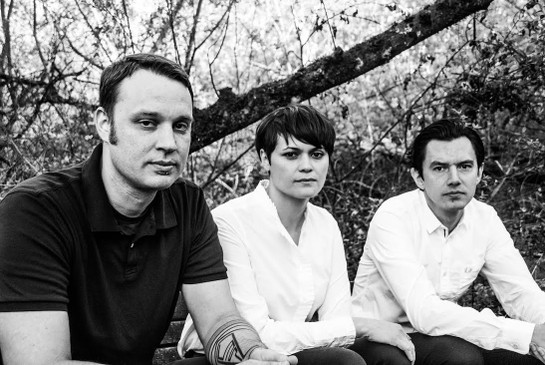
The first thing you guys released was an EP in 2014 called Dragon Mouth. From the start, I loved the combination of Irene's melodic vocals and your guitars, especially on the driving sections, like in the song "Cusp." There's an almost pop feel to the way her vocals float around.
Yeah, for sure. I knew with this band I wanted it to be more accessible than anything I had done before. I've already done obnoxious rock/punk and hardcore bands so I wanted to see if I could push myself into a more pop-oriented realm. I think my personality from my previous bands is still in there and will never go away, but trying something new was important to me. Irene, I thought, was perfect for that. In some ways we're still an obnoxious rock band and having Irene sing really takes away from that in a perfect way. It's an interesting mix of two worlds.
Joel from your label sent me an advance of Scale and after listening to it four or five times so far, I think introducing the album to the public with the song "Lift" was smart. That track does a fine job of presenting many of the moods the rest of the album offers.
Oh, I totally agree. For me it's always tough to determine what the first single will be. We've been so close to this record for so long that it's hard to pick a favorite, you know? So, that song was [The Mylene Sheath owners] Joel and Lindsay's idea as to what to lead with and I couldn't agree more. It has some of our spacier moments, and heavier as well. We're a bit more traditional in the arrangement department as well with this batch of songs.
With Scale, I feel that Dust Moth could appeal to a wide range of people. I could see fans of doom, post-rock, metal, and even stuff like Deftones and Tool getting into it.
It's tough for me to comment on that as well. We're really hoping a ton of folks understand what we're going for and can get into it. We'll see for sure.
SEE ALSO: Catastrophic Visions: Industrial Noise in 1990s Peru
Outside of Dust Moth, do you have any projects you're working on, musically or otherwise?
Yeah, I've got a batch of songs I work on a decent amount. Just ideas that don't really fit with any bands I have going. The collection is growing quite a bit [laughs]. Maybe they'll make their way into something at some point. This is ridiculous to mention, but my girlfriend and I got a dog last year and we spend most of our time hanging out with him. He is the best. Without a doubt he is the greatest.
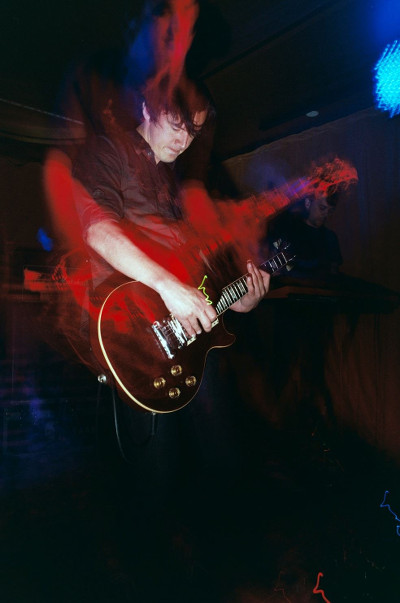
Is there a musical artist you love that you don't know anyone else who listens to?
There are some artists or bands I enjoy that I think should be huge, but maybe they're not? Suzanne Kraft is fantastic. The new Mamiffer record is incredible. I love Tim Hecker, The Haxan Cloak, and stuff like that, but I don't think they're unknowns by any means. Same with the band Sisu. They are fantastic and I would love to do some shows with them.
I love moody and atmospheric music, if you hadn't noticed [laughs].
Last question: would you be open to a Nineironspitfire reunion show?
I think you might be the only person interested in that [laughs]. Any time I could get to play with Demian, I would jump at it.
***
Dust Moth's debut album, Scale, will arrive in stores on July 22 and can be pre-ordered from The Mylene Sheath.
